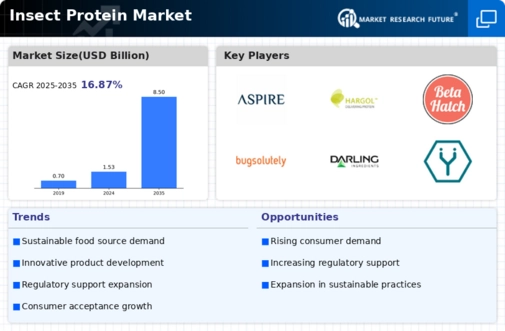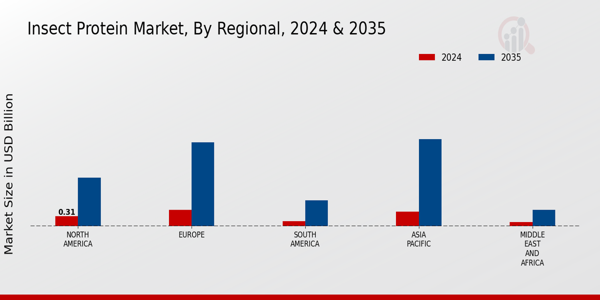Regulatory Support
Regulatory support is emerging as a significant driver for the Global Insect Protein Market Industry. Governments worldwide are recognizing the potential of insect protein as a sustainable food source and are implementing policies to facilitate its production and consumption. For instance, the European Union has established guidelines for the use of insects in food and feed, which encourages innovation and market entry. This supportive regulatory environment is likely to enhance consumer confidence and stimulate market growth, paving the way for broader acceptance of insect protein in mainstream diets.
Rising Protein Demand
The Global Insect Protein Market Industry is poised for growth due to the rising global demand for protein. As populations expand and dietary preferences evolve, there is an increasing need for alternative protein sources. Insects provide a highly nutritious option, containing essential amino acids, vitamins, and minerals. The market is projected to reach 8.5 USD Billion by 2035, reflecting a growing acceptance of insect protein in various sectors, including human consumption and animal feed. This trend indicates a significant shift in consumer behavior towards sustainable and nutritious food sources.
Sustainability Concerns
The Global Insect Protein Market Industry is increasingly driven by sustainability concerns. As traditional livestock farming contributes significantly to greenhouse gas emissions, the shift towards insect protein presents a more environmentally friendly alternative. Insects require considerably less land, water, and feed compared to conventional livestock. For instance, crickets need only 1.7 kg of feed to produce 1 kg of protein, whereas cattle require about 8 kg. This shift aligns with global efforts to reduce carbon footprints and promote sustainable food sources, potentially leading to a market valuation of 1.53 USD Billion in 2024.
Market Growth Projections
The Global Insect Protein Market Industry is anticipated to witness substantial growth, with projections indicating a market size of 1.53 USD Billion in 2024 and an impressive rise to 8.5 USD Billion by 2035. This growth trajectory reflects a compound annual growth rate of 16.87% from 2025 to 2035. Factors contributing to this expansion include rising protein demand, sustainability concerns, and increasing consumer acceptance of insect-based products. The market's evolution is likely to reshape the food industry, offering innovative solutions to meet global protein needs.
Technological Advancements
Technological advancements play a crucial role in the Global Insect Protein Market Industry. Innovations in farming techniques, processing methods, and product development enhance the efficiency and scalability of insect protein production. For example, automated farming systems and bioconversion technologies improve yield and reduce costs. These advancements not only make insect farming more viable but also contribute to the overall growth of the market, which is expected to experience a compound annual growth rate of 16.87% from 2025 to 2035. This technological evolution is likely to attract investment and foster further research in the sector.
Consumer Awareness and Acceptance
Consumer awareness and acceptance are pivotal in shaping the Global Insect Protein Market Industry. As educational initiatives and marketing campaigns highlight the nutritional benefits and environmental advantages of insect protein, public perception is gradually shifting. Surveys indicate that a growing number of consumers are open to incorporating insect-based products into their diets, particularly in regions where food security is a concern. This increasing acceptance is expected to drive demand, contributing to the market's projected growth and fostering a more diverse range of insect protein products.




















